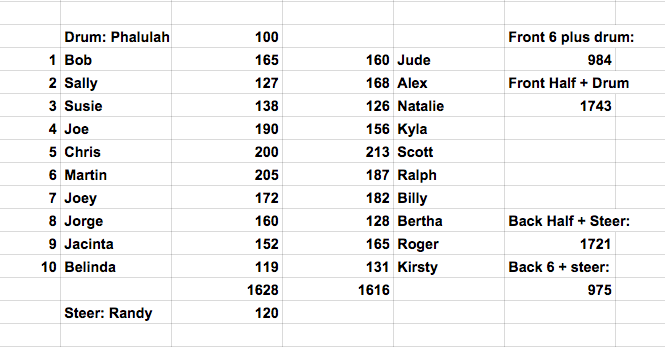How to Balance a Dragon Boat: Tips for Your Most Successful Race Boat Layout
Balancing a boat is essential for a race, but many teams overlook exactly how crucial it can be to their success. Having a properly balanced boat not only makes it easier on the steersman, it also allows the boat to glide through the water evenly. But balance doesn’t only apply to the left and right sides of the boat. Your race boat needs to be balanced front to back as well.
Recreational teams will often encourage paddlers to find a “partner paddler” who is more or less the same weight. This will result in an approximation of a left-right balanced boat, but will certainly not be accurate. Competitive teams precisely balance their boat by taking each paddler’s weight and carefully calculating the left and right side weights, as well as the front and back weights.
Having a properly balanced boat not only makes it easier on the steersman, it also allows the boat to glide through the water evenly.
There are many different philosophies about balancing a boat, but as a coach, this is my approach:
- First I make sure to have updated weights on each paddler who will be on the race boat. The best way to get accurate weights is to bring a scale to a practice session. When paddlers self-report their weight, they often give a weight that they hope to be instead of what they actually are. I once had a paddler tell me that she was 35 pounds lighter than she actually was. This can cause big issues in the final boat balance.
- I use an Excel spreadsheet with formulas to calculate the summation of the weights in three areas: left/right, front/back, and front 6+drummer/back 6+steer.
- I start entering paddlers into the spreadsheet according to their paddling side preference and position (i.e. strokers, engine room, rockets, etc.). I take into account each paddler’s size and height – obviously some paddlers fit better in certain parts of the boat than others.
- Once the paddlers are placed in the spreadsheet, I look at side-to-side balance. This is where I truly value paddlers who can paddle both sides because I can swap them around to help achieve my perfect left-right balance. I aim to have my left-right weight differ by no more than 30 pounds. I love it when I get it within 10 pounds!
- Then I consider my front-back balance. My preference is to have the front half of the boat be slightly heavier than the back half because as the boat picks up speed during the start, the idea is to have it up on a plane. You don’t want your rear end dragging down the course, so you would never want to start with a boat that is back-heavy. A slightly front-heavy boat will have its bow picked up as the hull sped increases so that the boat is level.
- Next I consider my front 6 + drummer and my back 6 + steer. These are the ends of the boat and therefore you don’t want too much of a difference. Your front-back balance might be perfect, but if you overloaded your back six paddlers, your boat is still going to act back-heavy. And take it from me, when you steer a back-heavy boat it feels awful and sluggish. I aim to get the front 6 + drummer only slightly heavier than the back 6 + steer; within 10 pounds is great.
Here is an example of what my spreadsheet will look like as I work on it:
Keep in mind that when you rotate in a spare or substitute paddler, you will likely need to rebalance your boat. If you sub in a paddler on the left who weighs 135 pounds for a paddler who weighs 198 pounds, the total weight of your left side just dropped by 63 pounds, which will affect your balance. Therefore, you will hopefully either have another sub or spare that you can rotate in to help create the balance, or you will have a few paddlers who can paddle on either side and so you can move them around and swap them from left to right or vice versa to achieve your balance. Paddlers should be flexible enough to paddle in a variety of different locations and behind a variety of different paddlers.
A lot goes into balancing a boat and on top of the numeric values, you have to carefully consider the abilities of each paddler. Ideally, you will have a wonderfully competitive boat where every paddler is above-average to excellent. But this is not reality. So, in many cases, you have to find the right balance between placing a less-competent paddler in a seat where they won’t be disruptive to the timing, and balancing your boat accurately. There is no correct formula for this, so a coach needs to experiment with what works. Try out different configurations during practices and find what is most successful for your team.
Good luck with your boat layouts!







I agree it is very important to do balance calculations, but there are a few errors in your approach. Firstly it is also important to take into account the leverage of the weights . I.e. the distance of the weight from the center of buoyancy. For example the drummer is further from the centre of the boat than the steerer so their weight (and don’t forget the weight of the drum and seat) has a proportionally greater impact on boat trim than the steerer’s weight. Also, the center of buoyancy is not necessarily in the middle of the boat. BuK told me that for their boats the COB it is 20cm in front of the middle seat. I don’t know the info for other brands, but worth checking if you want accurate calculations for boat trim.
On the other hand, the boats are about 11m long on the waterline so a slight front/rear imbalance has little effect. I guess 50kg difference would change the trim angle by less than 1 degree. It would be worth checking this by balancing the boat, than adding a certain amount of weight to the drummer’s or steerer’s position and measuring the change in height of the nose (or tail) above the water. A 40mm change in height equates to a change in trim angle of about 0.5 degrees.
There is also an App for this https://itunes.apple.com/us/app/d.b.t.-dragonboat-tools/id465917759?mt=8 and someone in Australia has also developed an App, but I can’t find the link for that at the moment.
Thanks for your input. It’s always good to learn other approaches, so I appreciate you taking the time to add your comment here. Also, thanks for the info about the apps – the last time someone shared an app with me it only balanced left-right, so I wasn’t overly impressed with that one. I will definitely check these out. Thanks again!
Here’s the link to the Australian App website http://www.dragonking.com.au/. There are no specs but the App is used to gather a lot of data on paddlers so I assume it does balance calculations as well.
Someone in Germany also developed a balance calculator spreadsheet which can be downloaded here http://www.dragonboatworldinternational.com/Download.php
It is OK, but doesn’t consider leverage.
Awesome! Don’t give away your secrets! Lol! Diana
Sent from my iPhone
>
I just did some calculations to see how much the center of gravity moves with front/rear imbalance. Assuming a total crew weight of 1600kg and changing the balance by 100kg (from 800/800 to 850/750) only shifts the centre of gravity by about 30cm. This should have little impact on resistance. Better just focus on minimising total crew weight. A 10kg reduction in total crew weight reduces 500m time by about 1 sec (if moving at 4m/s average).
However, I think that one of the major benefits of spending time on fine tuning weight balance is that it gives the crew confidence that things are done ‘right’ and they will perform better. So whatever method you use, understand its impact, be confident about it, and make sure the crew understands what you are doing and why.
Thanks for your added information! Adding to your last paragraph, which is indeed true, I would say that explaining boat balance helps crews, especially the less experienced crews, to understand why specific people are needed in specific seats. I took for granted that crews understood this until I began working with one particular crew. When I subbed paddlers in and out, a few asked me why their seats were changing. It was a great learning moment!
Thanks again for your input!
… and here’s another useful app https://play.google.com/store/apps/details?id=com.plaincode.clinometer . This provides an easy way to measure front/rear and left/right balance to 0.1 degree.